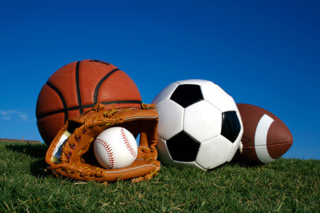 We've braved yet another winter of snow, ice and SEPTA delays, and in just a few weeks, we'll be rewarded with the first official day of spring.
We've braved yet another winter of snow, ice and SEPTA delays, and in just a few weeks, we'll be rewarded with the first official day of spring.
In fact, spring is so close that we recently celebrated the kick-off of the new Major League Baseball (MLB) season with the beginning of spring training. Beyond baseball, with spring comes frisbee, soccer, softball, track & field, and more -- and not just for the professionals, but for everyone who has been cooped up for months, just waiting for the thaw.
Unfortunately, with all the fun, also come sprained ankles, torn ACLs and a host of other maladies. In fact, according to recent research co-authored by faculty from Penn Orthopaedics shows that on average large-scale track and field events result in at least two major orthopaedic and seven major medical injuries, per 10,000 participants. Additionally, the study showed that minor orthopaedic injuries, such as sprains and strains, are the most common.
"People are always eager to get back outside as soon as it warms up, which is great, but it's also when we start to see a sharp increase in patients suffering from sports injuries," said Brian Sennett, MD, chief of Sports Medicine at the Perelman School of Medicine at the University of Pennsylvania. "During the winter months, we tend to see a lot of snowboarding and skiing injuries, but there are so many more spring and summer sports that can lead to severe, and even ‘career’ ending injuries if not cared for properly."
As people try to get fit by spending time outdoors exercising, their bodies are experiencing a world of strain and pressure, often resulting in excruciating pain, or even a season on the bench. But, whether you're getting ready for track and field or bocce, Penn's Sports Med docs say there are ways to avoid the most common sports injuries and stay healthy.
Runner's Knee
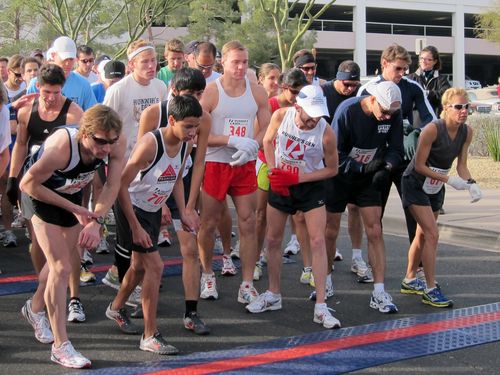 Research shows that knee injuries comprise about 55 percent of all sports injuries and approximately one-fourth of all problems treated by orthopedic surgeons. Because of its impact on the entire body, running is by far the most common sport that leads to knee injuries. While some, like ACL tears (which we'll get to later) are more severe and in a class of their own, many of the minor injuries fall into the category of "Runner's Knee," which includes a range of aches and pains related to the kneecap and surrounding area. Runner's knee occurs most often when athletes of any sport that involves running don't allow enough recovery time. When overused, the knee can become worn down, irritated, or affected by arthritis.
Research shows that knee injuries comprise about 55 percent of all sports injuries and approximately one-fourth of all problems treated by orthopedic surgeons. Because of its impact on the entire body, running is by far the most common sport that leads to knee injuries. While some, like ACL tears (which we'll get to later) are more severe and in a class of their own, many of the minor injuries fall into the category of "Runner's Knee," which includes a range of aches and pains related to the kneecap and surrounding area. Runner's knee occurs most often when athletes of any sport that involves running don't allow enough recovery time. When overused, the knee can become worn down, irritated, or affected by arthritis.
"Rest days are crucial for the body's recovery, and help prevent chronic muscle and tendon injuries from developing. When an athlete feels pain in the knee, it's a warning sign that should be taken very seriously," says Rahul Kapur, MD, director of the Penn Primary Care Sports Medicine Fellowship. "A period of rest or lower-impact cross-training, such as biking or swimming, can help prevent an irritation from becoming something more severe. Other treatment options might include a new pair of athletic shoes or inserts to help correct flat feet or other arch issues, a short course of anti-inflammatory medications, or even a knee brace. Long term, the best option is to do proper rehab focusing on the quadriceps, hips, and core to correct alignment issues and prevent the kneecap from tracking incorrectly."
Strains and Sprains
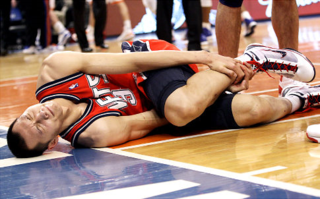 Strains and sprains can affect a number of muscles, ligaments and tendons. With proper care and rehabilitation, these injuries can generally be healed without having to take a whole season off.
Strains and sprains can affect a number of muscles, ligaments and tendons. With proper care and rehabilitation, these injuries can generally be healed without having to take a whole season off.
Sprains most commonly occur in wrists, ankles, or knees, and are the result of overstretched ligaments. Ankle sprains, for example, often occur when an athlete lands on the foot incorrectly, causing the foot to roll to the outside, which in turn sprains the ligaments on the outside of the ankle.
Strains, similar to a sprain, also occur when the fibers of a muscle or tendon are stretched too far. Also known as a pulled muscle, strains are often the result of overuse or overstretching a muscle, or using it without properly warming up. Quad and hamstring strains are common because the muscles are used in nearly every physical activity, and particularly in those that put a lot of pressure on the legs. Groin pulls or strains are also common in sports like soccer, where the athlete is suddenly changing direction.
Whether you have a strain or a sprain, sports medicine doctors say that aside from rest, ice and anti-inflammatories, a critical component to recovering from these injuries is making sure to rebuild the muscle to avoid re-injury.
"Without proper rehabilitation, there's a chance that a sprained or strained muscle will develop into scar tissue, which increases the likelihood of re-injuring the muscle, and potentially more severely," said Milt Zgonis, MD, assistant professor of Orthopaedic Surgery. "After a period of rest, and once cleared for physical activity by a medical provider, athletes can begin gentle weight-bearing exercises to rebuild the muscle, and eventually return to pre-injury health and performance."
ACL Tear
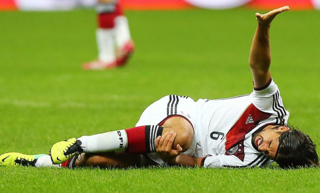 The ACL is a ligament that connects the femur and tibia. Strains and tears of the ACL are often severe and require long periods of rehabilitation. Surgery is often necessary to replace a torn ACL.
The ACL is a ligament that connects the femur and tibia. Strains and tears of the ACL are often severe and require long periods of rehabilitation. Surgery is often necessary to replace a torn ACL.
ACL tears are common among athletes participating in sports like soccer and basketball where sudden stops and changes in direction are frequent and intense amounts of pressure are placed on the knee. Accompanied by a "popping" sound, ACL tears commonly result in an unstable feeling or “shifting” sensation. Though there are several surgical options to treat a torn ACL, nearly all require lengthy and careful rehabilitation and a gradual return to physical activity.
"Anyone who suspects they may have an ACL tear should seek professional medical advice immediately," said James Carey, MD, MPH, director of the Penn Center for Cartilage Repair and Osteochondritis Dissecans Treatment. "Though some people can live comfortably without having an ACL injury treated surgically, often patients feel unstable and are unable to return to pre-injury activities."
Tennis Elbow
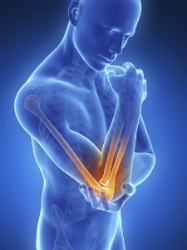 Though there is a wide range of injuries related to the hips and legs, elbow injuries account for nearly seven percent of all sports injuries. Tennis elbow in particular plagues many athletes whose arms, forearms and hands are not properly strengthened to handle the amount of stress being placed on them, or whose game techniques cause undue strain. While tennis elbow is caused by tendon degeneration and strain on the outside of the elbow, golfers may experience a form of tennis elbow on the inside of the non-dominant hand as a result of pulling the club through their swing.
Though there is a wide range of injuries related to the hips and legs, elbow injuries account for nearly seven percent of all sports injuries. Tennis elbow in particular plagues many athletes whose arms, forearms and hands are not properly strengthened to handle the amount of stress being placed on them, or whose game techniques cause undue strain. While tennis elbow is caused by tendon degeneration and strain on the outside of the elbow, golfers may experience a form of tennis elbow on the inside of the non-dominant hand as a result of pulling the club through their swing.
"The best way to prevent elbow injuries is to make sure the muscles and tendons in your hands, arms and forearms are properly strengthened and prepared," said John D. Kelly, IV, MD, director of Sports Shoulder. "Wrist curls, reverse wrist curls and squeezing strengthening balls and grips can help, but ultimately the best prevention is improved technique."
Low Back Pain

Low back pain is a common cause of disability in the general population, and also affects athletes across a wide range of sports. Low back pain is common in rowers, cyclists, golfers, racquet and ball players, and can be indicative of severe injuries like disc herniations or fractures. In athletes, low back pain is very common in those who participate in repetitive unilateral motions, such as the golfer who only pivots the spine in one consistent direction during their swing. This can lead to asymmetric loading of the spine and changes the normal mechanics of the back. Gymnasts, divers and other athletes whose sports require arching (hyperextension) of the spine, can develop stress fractures from repetitive overloading of the spinal structures. Heavy lifting, especially with improper form is another risk factor for low back injury.
"During their careers, many athletes will experience some form of back pain, with varying degrees of associated disability," said Kate Temme, MD, assistant professor of Sports Medicine in the department of Orthopaedic Surgery. "Many injuries are mild, such as muscle strains, and will resolve with a short period of relative rest and symptomatic relief. Bed rest is often counterproductive, and can actually prolong the recovery phase. Activity modification eliminates the offending activity, but keeps the spine moving and facilitates recovery. Physical therapy may be recommended to help restore normal spinal motion, promote core strengthening and optimize flexibility while addressing any underlying abnormal biomechanics. Any athlete whose symptoms progress or fail to improve, should seek medical attention. Regardless of the severity of injury, once cleared to return to sport by a medical professional, athletes should continue to optimize strength and flexibility while maximizing technique to help prevent re-injury.”